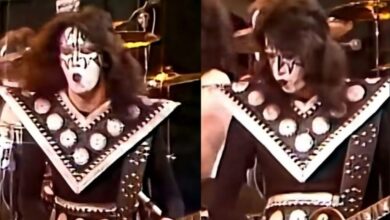Marty Robbins’ “Am I That Easy to Forget” Redefined Heartbreak Ballads and Cemented His Cross-Genre Brilliance in the Late 1960s
Released in 1969, Marty Robbins’ rendition of “Am I That Easy to Forget” offered a hauntingly vulnerable performance that resonated with listeners far beyond country’s traditional borders. While the song had already enjoyed earlier success through versions by Carl Belew and Engelbert Humperdinck, Robbins brought an emotionally nuanced delivery that transformed the track into a transcendent experience. Its melancholic tone, mixed with Robbins’ smooth vocal phrasing, gave the song new weight, pushing it into the Top 10 on country charts and finding surprising resonance with adult contemporary audiences. This version became a touchstone for heartbreak ballads at the tail end of the decade.
By the time Robbins recorded this ballad, he was already a versatile and widely celebrated artist. Born in 1925 in Glendale, Arizona, Robbins had climbed the ladder from small-town radio appearances to becoming a national star by the mid-1950s. Known for his uncanny ability to navigate Western ballads, rockabilly tunes, and romantic standards, Robbins defied categorization. Hits like “El Paso” and “A White Sport Coat (And a Pink Carnation)” showcased his storytelling prowess, but it was songs like “Am I That Easy to Forget” that reminded audiences of his deeply emotive undercurrent.
Though Marty didn’t write the song—it was penned by Carl Belew and W.S. Stevenson—the selection was anything but arbitrary. Robbins had a gift for identifying lyrics that matched his own life’s undercurrents, and many believe he gravitated toward the song during a period of personal reflection. His version is slower and more plaintive than the others, imbued with an aching sense of resignation. There’s a story, perhaps apocryphal, that Robbins requested multiple takes not to perfect the pitch but to find the most emotionally convincing delivery—he wanted the listener to feel like they were overhearing a man losing the love of his life.
The recording process reflected Robbins’ typical perfectionism. Produced in Nashville under Columbia Records, the track featured a delicate orchestral arrangement rather than the steel guitars common in his earlier hits. The production leaned heavily on strings and piano, allowing Robbins’ voice to sit squarely at the center of the sonic palette. His phrasing—gentle, almost whisper-soft at times—drew the listener inward. The restraint of the arrangement emphasized the emotional gravity, making the sorrow in the lyrics feel profoundly intimate.
Upon release, Robbins’ version climbed to No. 7 on the Billboard Hot Country Singles chart. Though Engelbert Humperdinck’s 1967 version had already made waves internationally, Robbins’ interpretation was uniquely embraced by the country music community and reaffirmed his status as one of the genre’s most adaptable vocalists. While it didn’t cross over to pop charts in a major way, it found significant radio play in adult contemporary formats, proving that Robbins’ appeal extended well beyond traditional country audiences.
Culturally, the song played a crucial role in softening the boundaries between country and pop. At a time when genres were becoming increasingly siloed, Robbins reminded audiences that emotional sincerity and lyrical craftsmanship transcended musical labels. His cover became a reference point for country artists looking to dabble in broader sonic textures without alienating their base. It was a quiet revolution, and Robbins, with his velvet tone and understated conviction, was its soft-spoken general.
Professionally, “Am I That Easy to Forget” marked a turning point in Robbins’ late-career strategy. Though still producing charting singles, he began to lean more into adult ballads and orchestral-backed arrangements, distancing himself from the cowboy narratives that had defined his earlier years. The song’s success offered Robbins the freedom to continue exploring the softer, crooning side of his voice in the years that followed, opening doors to lounge performances and international bookings that might have once seemed out of reach for a country stalwart.
Its influence rippled out, especially among country crooners like Don Gibson and Jim Ed Brown, who followed suit with similar orchestrated heartbreak songs in the early ’70s. Robbins’ version became a touchstone not just for singers, but for producers and arrangers looking to bridge Nashville and Las Vegas sensibilities. The song encouraged artists to reexamine slow tempos and lush arrangements as legitimate expressions of emotional depth, rather than relics of the past.
“Am I That Easy to Forget” would also see multiple covers following Robbins’ version, with country legends like Skeeter Davis and George Jones recording their own interpretations. Though none reached the commercial or emotional heights of Robbins’ take, they each paid homage in their own way to the interpretive groundwork he had laid. Robbins’ influence lingered in each of them like a soft echo from a song that refused to fade.
At the time of the song’s release, Robbins was also dealing with fluctuating health and the pressures of a relentless touring schedule. Yet rather than slowing down, he poured his energies into music that reflected vulnerability and grace. Some biographers believe this track symbolized a shift in Robbins’ public persona—from heroic storyteller to aging romantic, aware of time’s passage and love’s fragility.
In the decades since, Robbins’ version has remained a staple on classic country playlists and satellite radio stations. Its staying power is due not just to the song itself, but to Robbins’ masterful reading of its sorrow. He didn’t oversell the grief—he let it linger, unresolved, much like the heartbreak the lyrics describe. This authenticity made it timeless.
On a broader musical scale, the song laid the groundwork for future genre crossovers by artists like Kenny Rogers and Glen Campbell, who would use similarly lush instrumentation and crossover melodies to dominate both country and pop charts in the 1970s and beyond. Robbins may not have been aiming for revolution, but his subtle shifts helped change the way country ballads were recorded and received.
Though Robbins passed away in 1982, his legacy has only grown stronger. Posthumous honors from the Country Music Hall of Fame and a Grammy Lifetime Achievement Award cemented his importance, but it’s the intimate moments in songs like “Am I That Easy to Forget” that continue to define his place in listeners’ hearts. His voice, suspended somewhere between cowboy grit and romantic despair, remains unmatched.
Ultimately, “Am I That Easy to Forget” endures not because it reinvented the wheel, but because it used a familiar vehicle to travel deeper into the human experience. Marty Robbins didn’t just sing about heartbreak—he invited us into it, made us sit with it, and somehow, left us better for having listened. In doing so, he redefined what it meant to be a storyteller in a changing musical landscape.





